I remember taking a gas-station air pump once to my deflated motorcycle tire in the middle of a road trip. That ordeal I went through was a stark reminder of the importance of maintaining correct tire pressure. Imagine my relief when the reinvention of the classic tire pressure gauge into a smart device came into play. Back in the day, a weekly tire pressure check was my ritual. Nowadays, a motorcycle TPMS system does that for me.
Without giving too much away, just let me say, this night and day change profoundly impacted my motorbiking experience. If you’re a motorcycle enthusiast like me, you need to understand the potential of this underrated device. It’s simple, it’s sleek, it’s surprisingly crucial. Yes, we’re talking about the unsung hero – Motorcycle Tire Pressure Monitoring Systems (TPMS).
From pulling over at gas stations to now merely glancing at a digital screen, the evolution is immense. This comprehensive guide will navigate you through this revolutionary technology, one tire at a time. So, gear up to immerse yourself into the fascinating world of motorcycle TPMS. Trust me, this ride is going to be astonishingly innovative and enlightening.
Understanding TPMS Technology
Bluetooth and Wireless Systems
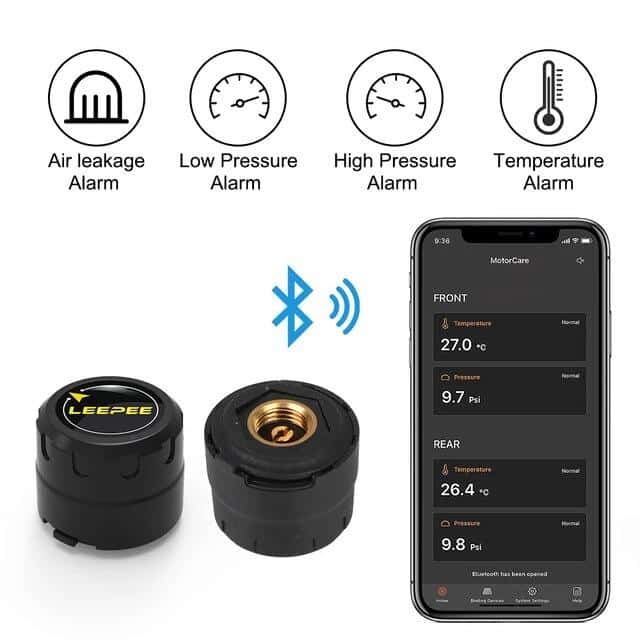
As we delve deeper into understanding the complexities of TPMS technology, it’s impossible not to appreciate the leaps and bounds Bluetooth and wireless systems have made on progressive motorcycle safety tools such as this. As an enthusiastic technophile, I’ve seen my fair share of devices revolutionized by wireless technology and Bluetooth incorporation. This includes the Bluetooth tire pressure monitoring system now available for our faithful two-wheelers.
With experience comes enlightenment. I’ve been perplexed at times by Bluetooth connectivity in numerous bike gadgets. But believe me, the convenience it adds to TPMS is amazing. The ability to instantly broadcast and receive crucial tire pressure information on your smartphone can make all the difference. Especially as someone who respects the nuances of technology, I find this truly impressive; it strikes me as a brilliant manifestation of cutting-edge wireless TPMS for motorbikes.
Take, for example, models featuring the Bluetooth 5.0 technology. These devices provide a much faster transfer of data, greater range, and are more energy-efficient, attributes that resonate clearly with the benefit aspect of the FAB model. The improvement in connectivity and precision that Bluetooth 5.0 offers enhances the reliability of these TPMS devices, making them an absolute necessity for our rides.
What started off as a fad in technology has morphed into a conventional, and now almost indispensable tool for motorcycle safety. The convenience that accompanies a Bluetooth TPMS cannot be understated. Having real-time access to your motorcycle’s tire pressure at your fingertips is a game-changer; it aids in better controlling the motorcycle, preventing accidents, and increasing the lifespan of the tires.
Witnessing the evolution of TPMS from simple systems to advanced wireless devices, one cannot ignore the profound difference that Bluetooth connectivity contributes. And as we progress in our discussion, you will further see the importance of seamless integration and adaptability of the TPMS into our daily motorcycle routines.
TPMS App Integrations
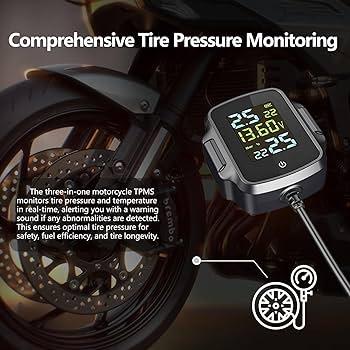
Continuing from the relevance of Bluetooth and wireless systems in TPMS, another crucial facet that streamlines our interaction with these systems is the integration of TPMS into our smartphones. Be it an android TPMS app or an iOS TPMS app, incredible convenience is added to our motorcycle TPMS experience through these applications.
In my consulting years, I’ve seen apps revolutionize the auto industry. With the advent of a motorcycle TPMS app, it ensures that critical tire pressure info is never more than a few taps away. Having worked with various driver assistance technologies, I feel the introduction of TPMS apps was a game-changer. It gave riders an easier, more straightforward way to monitor and adjust tire pressure, which reinforces a key goal of TPMS: to make motorcycles safer and fuel-efficient.
These apps typically offer real-time data right on your smartphone, alerting you promptly if the tire pressure drops too low or rises too high. Most of these apps are quite user-friendly, allowing riders to track the health of their tires without needing a lot of technical knowledge. With their integration, you are not just interacting with a system but a comprehensive and easy-to-navigate tool that makes motorcycle maintenance less of a chore.
Such app integrations make TPMS more potent than ever, providing riders with detailed, real-time insights at their fingertips. On long rides, these apps work wonders by continuously monitoring tire conditions, permitting the rider to focus more on the road and the ride, rather than worrying about their tire pressures.
In conclusion, app integrations have notably enhanced the accessibility and utility of TPMS, making the technology a darling of modern riders. As we pave our way towards more technologically equipped motorcycles, the holistic integration of such apps helps to cement the importance of digital interfaces in enhancing rider safety and convenience.
With a glance into TPMS App Integrations, we unravel more into their practicality in our next section ‘Comparing TPMS Brands and Models’, where we look at the market’s offering, their differential features, and what suits your requirements best.
Comparing TPMS Brands and Models
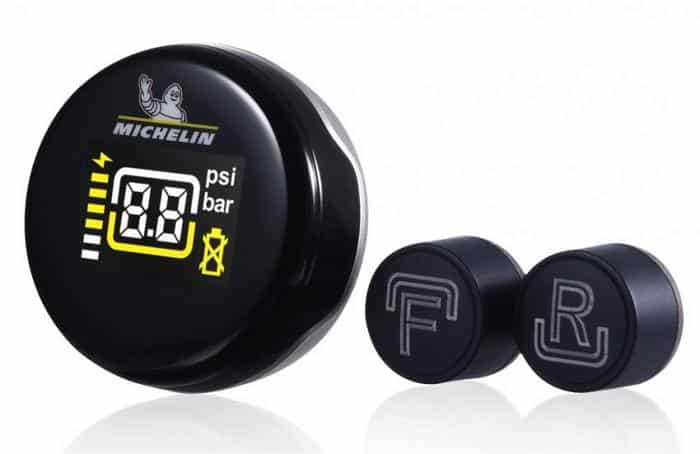
There’s an undeniable thrill in discussing gadgets, especially when it comes to the best motorcycle TPMS models. I’ve devoted countless hours to researching these marvels of technology, reading in-depth TPMS reviews, and embarking on my own exploratory investigations. Over time, I’ve come to know the distinct features, strengths, and weaknesses of different brands and models intimately, as if they were my personal acquaintances.
Anecdote time! I remember purchasing a cheap, off-brand TPMS a few years ago, thinking I’d struck a sweet bargain. I was thrilled as I fit the new TPMS valve caps onto my bike’s tires and revved up for a countryside cruising. However, my joy was short-lived when I noticed erratic readings on the receiver unit. Despite apparently functioning as it should, the device gave sporadic value, painting a picture of tire pressure that was akin to a roller coaster. Unreliable as it was, it felt like a faulty weather forecast rather than a trusty indicator. An important lesson was learned; not all TPMS are created equal, and quality cannot be compromised.
Reminiscence aside, let’s dive deeper into my findings. There are many competitive players in the TPMS market, each boasting distinctive features and credibility. Top among my favourites are the FOBO Bike 2 TPMS and the Tire-Safeguard Motorcycle TPMS. Delivering seamless performance, these models offer reliability and straightforward operability.
The FOBO Bike 2 brings digital tire pressure monitoring to your smartphone using Bluetooth 5.0 technology. With a user-friendly interactive app, it reports real-time tire pressure and temperature. It wins big in wireless convenience, making it a crowd favourite among tech-savvy riders.
In contrast, the Tire-Safeguard Motorcycle TPMS undeniably shines with its high-pressure accuracy. This model pairs with an LCD monitor that flaunts a clear display and gives riders simultaneous readings of tire pressure and temperature. Its robust battery life topped with user-friendly programming options caters ideally to long-distance riders.
Switching focus to the build, the quality of TPMS valve caps is a factor often overlooked but of critical relevance. Good models sport caps made of durable materials like brass or stainless steel that can withstand harsh environments without corroding or causing leaks. FOBO 2 and Tire-Safeguard both pass this test with flying colours.
However, the path to finding the best TPMS is not one-size-fits-all. It’s all about personal preferences, riding habits, and the tech appetite of the individual biker. Some may prefer sleek, modern TPMS with app integrations, while others may favor traditional models with independent displays. Regardless of personal preference, quality, reliability, and accurate reporting should remain non-negotiable.
Moving forward, we’ll delve into the nitty-gritty of installing a motorcycle TPMS. As each of us whispers our machine’s unique name in reverence, we fall into line, ready to equip our steeds with their new digital sentinels. Stay tuned, riders, as we delve further into the world of TPMS and its role in elevating motorcycle safety to new heights.
Installing a Motorcycle TPMS
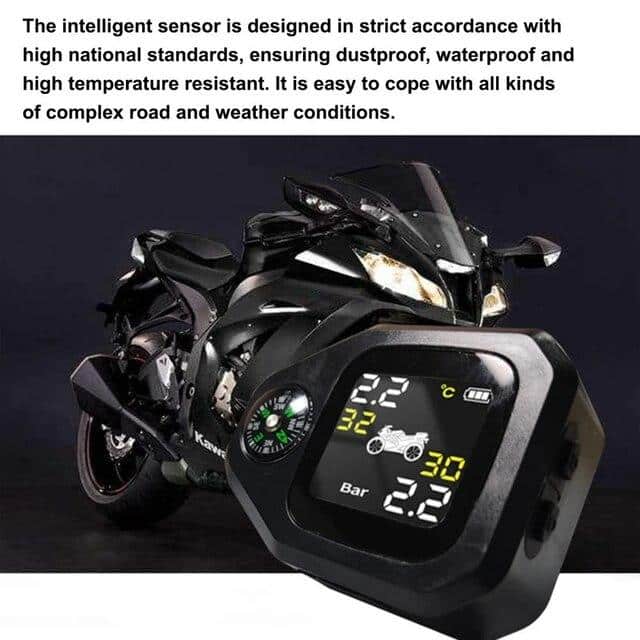
Having installed a TPMS on my motorcycle so many times that I’ve lost count, I can tell you with absolute certainty that it’s as easy as pie. Yet, there’s no harm in having a handy installation guide to refer to, right?
First things first, gather all the tools you’ll need. Most TPMS kits come equipped with everything you may require, but it’s always a good idea to have tools like a wrench and pliers within reach. Remember, organization is key when you’re trying to streamline any installation process.
I hope you’re still with me because, from now on, things get very interesting. Here comes the intriguing ‘Fascinating Facts’ part. Did you know that the necessity for TPMS was recognized after a law was passed in the United States? That’s right, in response to the 2000 Firestone tire failure fiasco involving numerous SUVs, Congress passed the TREAD Act. This legislation stipulated all vehicles produced after 2007 should have TPMS, making us realize how critical it is to have real-time tire pressure information. Now, isn’t that a fascinating reason behind the inception and evolution of TPMS technology?
Moving on from history back to our task at hand, let’s talk about the actual installing TPMS on a motorcycle process. Start by removing the tire valve cap and attaching the TPMS sensor. Ensure it’s screwed on tightly. If your system includes external sensors, the installation is likely done here. For those with internal sensors, there are a few more steps involved. With an internal TPMS, you’ll need to dismount the tire and place the sensor inside. This may seem daunting, but with some guidance and patience, it’s easily manageable.
Once you’ve attached the sensors, connect to whatever device your system uses to display information, whether that’s your phone or a separate display unit. Follow the instructions provided with your TPMS to accurately pair the devices. As is the case with any tool, make sure to test the system before you need to rely upon it. Play around with the settings, inflate and deflate your tires to check if the pressure readings are correct and familiarize yourself with any alerts or alarms your TPMS may have.
Lastly, glance over everything once again physically checking the installation. This step from my personal experience is called the ‘Instinctive assurance’ phase. It’s not in the manual, but I always feel more confident with my installation when I give it a final once-over.
With this personal tpms installation guide, I am confident you’d be a pro in no time. But, let’s not forget why you’re installing a TPMS in the first place. Trust me, the convenience and safety this small device offers is beyond expression. As we move forward, I am sure this tool will become indispensable to our motorcycling experiences.
Importance of TPMS in Motorcycle Safety
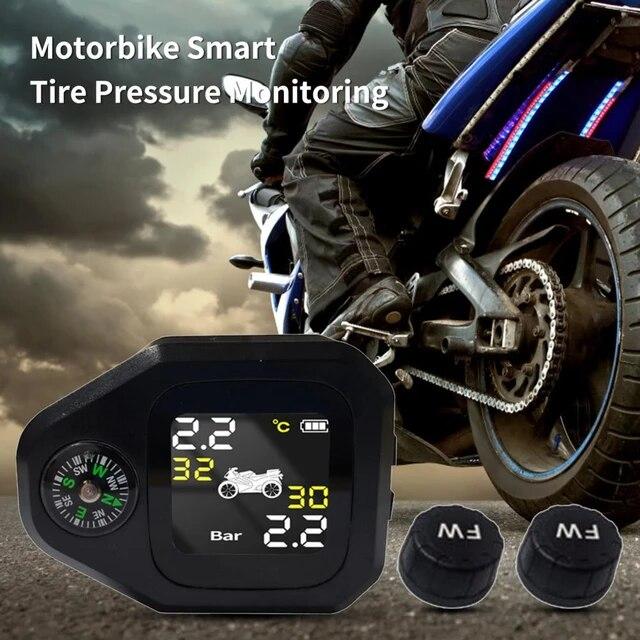
Having dedicated my career to championing tire safety, I can’t understate the game-changing nature of the Tire Pressure Monitoring System (TPMS) for our motorbikes. This ingenious addition to the roster of motorcycle accessories is nothing short of revolutionary when it comes to ensuring motorcycle tire safety.
And here’s a bold claim: I believe a TPMS system can augment motorcycle safety as significantly as helmets or protective riding gear. Although it might not be such an explicit indicator of safety like those, its role in maintaining tire health – and therefore, overall motorbike stability and control – is paramount.
A well-calibrated TPMS keeps watch over your tire pressures and alerts you the moment they sway from ideal levels. You don’t have to be a seasoned rider to understand the essential part this plays. Correct tire pressure means optimum contact with the road, better handling, improved fuel consumption, and reduced tire wear. In essence, it’s one of the most critical ride safety accessories, feeding you real-time, vital information about your motorcycle tire health when you need it the most.
This nifty device has saved me numerous times from road mishaps related to tire pressure. From a close shave in the backwoods, when my tire was slowly leaking air without my knowledge, to a trip through a busy city where the TPMS alerted me to over-inflated tires–the value of having instant access to your motorbike’s tire pressure status can’t be exaggerated.
Today, modern motorcycles are complex, sophisticated machines that rely heavily on electronic systems for advanced rider aids. However, tire pressure maintenance still largely remains a manual task, overlooked by many until it manifests a problem. In this context, a TPMS isn’t merely another gadget added to your motorcycle riding gear; instead, it’s a critical watchdog, ever-vigilant for any aberrations in your tire pressure. This constant vigilance boosts your safety quotient significantly by staying ahead of potential problems.
The crossroads of motorcycle safety and advanced technology is where TPMS systems arguably make one of the most invaluable contributions. They serve as your preemptive warning system, giving you the crucial chance to solve minor tire problems before they snowball into major, potentially life-threatening ones.
Motorcycle tire safety isn’t merely about responding to issues as they occur; it’s fundamentally about preventing them in the first place. With TPMS in place, you can ride with an added sense of security, knowing you’re one step ahead in maintaining optimal tire pressure for your adventures on the road.
I’d be remiss not to enthuse over what this means for us riders. With TPMS in our corner, we can focus more on the joy of the ride and less on worrying about what’s going on with our tires. Safety equipment like helmets and pads protect us, but a TPMS system is unique as it helps prevent incidents. It also extends your tire lifespan, providing long-term cost benefits.
It’s really quite simple – TPMS is an indispensable tool in our motorcycle safety arsenal. Its role in maintaining tire pressure, complemented by the invaluable motorbike tyre pressure alerts, are a win for every rider, regardless of style or experience. Few other accessories offer such impactful safety advantages as the humble TPMS. This is why its importance can’t be overstated – it’s about time we embrace this safety game-changer.
Additional Features of TPMS
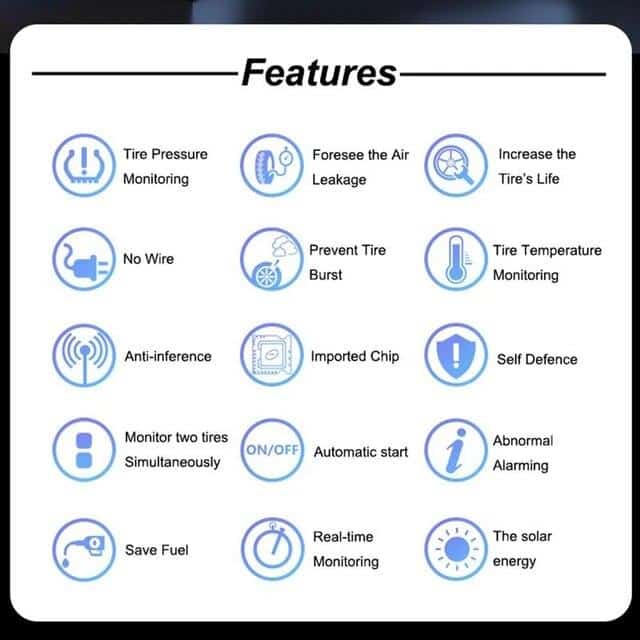
After several years on the road and countless miles under my belt, I’ve seen more than my fair share of motorcycle gadgetry and gizmos. Yet, of all the devices I’ve come across, the tire pressure monitoring system (TPMS) has become an indispensable part of my motorcycle ride. By delivering real-time tire pressure data directly to my handlebar display, TPMS has made a significant impact on my journey’s safety and performance.
But, there’s so much more to a modern-day TPMS than just pressure readings. In this part of the article, let’s plunge deeper into the additional features that TPMS kits today offer.
You know, modern gadgetry isn’t just functional – it’s built tough. My off-road biking sessions have attested to the durability of some of these TPMS models. For instance, the advent of waterproof TPMS has been a game-changer for riders like me, who enjoy the thrills and spills of off-road biking. Imagine sailing fearlessly through puddles and facing downpours, without worrying about the localized sensors damaging due to exposure to water.
Or perhaps, let me draw from a specific experience. On one of my cross-country bike rides, an unexpected lightning storm suddenly burst into action. Caught in the middle of the open plains, I had no other choice than to ride through it. My heart pounded with each crack of thunder, but I found comfort in knowing that the lightning-proof TPMS was doing its part to guard my ride by preventing electrical shocks from reaching the tires or impacting tire pressure readings.
The overhaul of technological advancements in TPMS has been astonishing, particularly, the tire pressure monitor sensor. It’s no longer just about pressure readings but also about temperature monitoring. As I ride, it’s essential that my tires are neither too hot nor too cold, and so, I rely heavily on the sensor’s readings, thereby maintaining an ideal balance between performance and tire longevity.
When discussing the enhanced features of TPMS, one cannot sideline the power-saving design. Let me tell you, my heart had sunk when I found my motorcycle’s battery dead during a road trip. Learning from that bitter experience, I invested in a powerful TPMS, boasting a power-saving feature for optimal performance while preserving battery life.
By now, I hope you comprehend the reason behind my fascination and praise for TPMS. It isn’t merely about the tire pressure readings or alerts but the sense of security they offer—putting my mind at ease while pushing boundaries on my motorcycle. Harnessing the full attributes of TPMS, from being weather resilient to preserving battery life, allows riders like me to hit the road with an added layer of safety and performance assurance.
In the upcoming section, we’ll continue exploring the importance of TPMS in motorcycle safety. Stay tuned as we dive further into the reasons why having this intelligent device isn’t just a luxury, but a necessity for any responsible motorcycle enthusiast.
FAQs
What is a Motorcycle Tire Pressure Monitoring System (TPMS)?
Why is a Motorcycle TPMS important?
How does a Motorcycle TPMS work?
How to install a Motorcycle TPMS?
Conclusion
Given the complexities of contemporary tire technology, it’s plain to see that installing a motorcycle TPMS is not a mere luxury, but a safety necessity. Numerous ride safety accessories add to our comfort and protection on the road, but few are as critical as this.
The best motorcycle TPMS products implement advanced technology – Bluetooth integration and wireless systems – to keep you informed. Few things, after all, are as vital as knowing precisely how your tires are performing in different conditions. The hard truths we’ve examined prove one point conclusively: TPMS technology saves lives. This is not speculation; these are cold facts, unembellished and raw.
You might have spent countless hours pondering the best handlebars, carefully selecting the ideal helmet, even studying high-performance engines in painstaking detail. All this is commendable; it speaks of your commitment to the ride. But to ignore tire health is to discount a vital, and often underestimated, piece of the puzzle.
In all my years of riding, the transformed sense of security and peace of mind brought by installing a motorcycle TPMS is both liberating and empowering. To be informed is to be in control. And, to be in control of your motorcycle, is to truly enjoy the freedom that comes with riding.
So, whether you’re a casual rider or on a quest for that adrenaline rush, a motorcycle TPMS is non-negotiable. It’s a compact life-saver, a rider’s insurance against unpredictability, and an investment in confident, conscious riding.
From everything I’ve shared, it’s clear why a motorcycle TPMS is an essential kit. Make the wise choice – stay safe, and enjoy the ride!